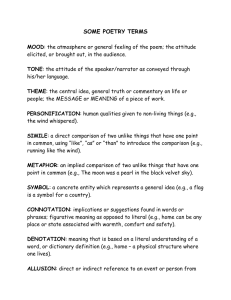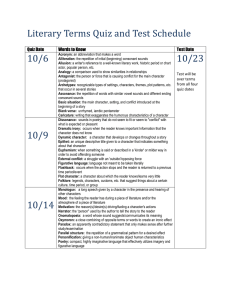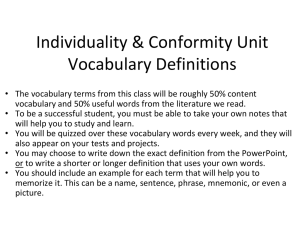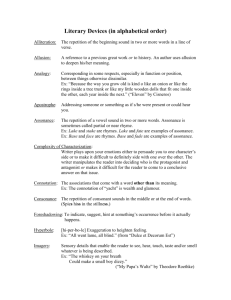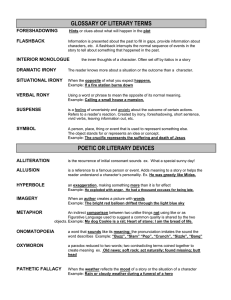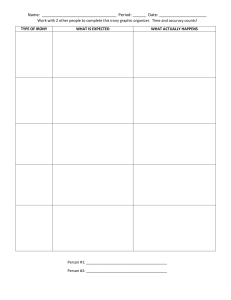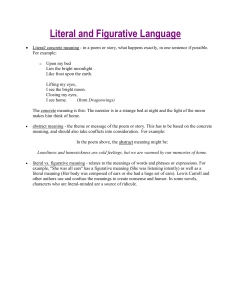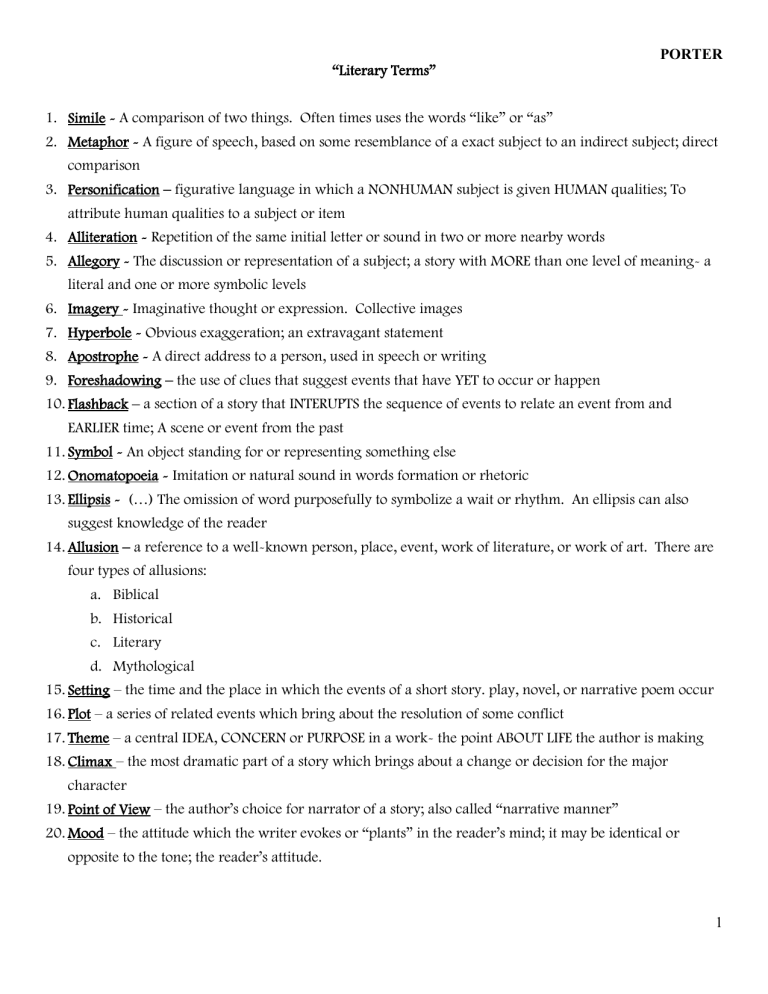
PORTER “Literary Terms” 1. Simile - A comparison of two things. Often times uses the words “like” or “as” 2. Metaphor - A figure of speech, based on some resemblance of a exact subject to an indirect subject; direct comparison 3. Personification – figurative language in which a NONHUMAN subject is given HUMAN qualities; To attribute human qualities to a subject or item 4. Alliteration - Repetition of the same initial letter or sound in two or more nearby words 5. Allegory - The discussion or representation of a subject; a story with MORE than one level of meaning- a literal and one or more symbolic levels 6. Imagery - Imaginative thought or expression. Collective images 7. Hyperbole - Obvious exaggeration; an extravagant statement 8. Apostrophe - A direct address to a person, used in speech or writing 9. Foreshadowing – the use of clues that suggest events that have YET to occur or happen 10. Flashback – a section of a story that INTERUPTS the sequence of events to relate an event from and EARLIER time; A scene or event from the past 11. Symbol - An object standing for or representing something else 12. Onomatopoeia - Imitation or natural sound in words formation or rhetoric 13. Ellipsis - (…) The omission of word purposefully to symbolize a wait or rhythm. An ellipsis can also suggest knowledge of the reader 14. Allusion – a reference to a well-known person, place, event, work of literature, or work of art. There are four types of allusions: a. Biblical b. Historical c. Literary d. Mythological 15. Setting – the time and the place in which the events of a short story. play, novel, or narrative poem occur 16. Plot – a series of related events which bring about the resolution of some conflict 17. Theme – a central IDEA, CONCERN or PURPOSE in a work- the point ABOUT LIFE the author is making 18. Climax – the most dramatic part of a story which brings about a change or decision for the major character 19. Point of View – the author’s choice for narrator of a story; also called “narrative manner” 20. Mood – the attitude which the writer evokes or “plants” in the reader’s mind; it may be identical or opposite to the tone; the reader’s attitude. 1 PORTER 21. Tone – the writer’s attitude toward the subject; words to describe these attitudes include these: serious, bitter, humorous, sympathetic, indignant, whimsical, joyous, mocking, ironic, apathetic, insulting, disgusted, businesslike, and logical 22. Conflict – a struggle between OPOSING forces- sometimes internal or external. There are 5 types of conflict. a. Man vs Man b. Man vs Himself (Internal Conflict) c. Man vs Nature d. Man vs Society e. Man vs Fate 23. Direct Characterization – when a writer STATES or DESCRIBES a character’s traits (personality) 24. Indirect Characterization – when a writer SHOWS a character’s personality through his/her ACTIONS, THOUGHTS, FEELINGS, WORDS, and APPEARANCE- or though ANOTHER character’s observations and reactions 25. Irony – 3 types a. Verbal Irony – words used to suggest the OPPOSITE of their usual meaning b. Dramatic Irony – a CONTRADICTION between what a character THINKS and what the audience KNOWS to be TRUE c. Irony of Situation – an event occurs that directly CONTRADICTS the expectations of the reader or the audience 26. Inference – any logical or reasonable conclusion cased on known facts or accepted premises/ situations 27. Antagonist – a character or force in conflict with the main character 28. Protagonist – the main character- the PERSON or FORCE at the center of the action 29. Suspense – a feeling of anxious curiosity the reader has about what is going to happen next in the story 30. Round Characters – are complex and multidimensional, like real people 31. Flat Characters – are one dimensional and superficial; they can be described in a single sentence 32. Dynamic Characters – change in an important way because of the story’s action. 33. Archetypes – Universal symbols found in literature that adds a deeper meaning to literature and cultures as they are used. 34. Myth- a traditional story passed down through generations that explain why the world is the way it is. Events usually results from actions of supernatural beings. 35. Creation Myth – explains how the universe, earth, and life began. There are also supernatural explanations of the world’s origin. 36. Syntax- The study of the rules whereby words or other elements of sentence structure are combined to form grammatical sentences. 2 PORTER 37. Figurative (Figurative Language)- Based on or making use of figures of speech; metaphorical: figurative language. Containing many figures of speech; ornate; Represented by a figure or resemblance; symbolic or emblematic. 38. Literal (Literal Language)- Conforming or limited to the simplest, nonfigurative, or most obvious meaning of a word or words. 39. Denotative Meaning - To serve as a symbol or name for the meaning of; signify: A flashing yellow light denotes caution. To signify directly; refer to specifically. 40. Connotative Meaning- The set of associations implied by a word in addition to its literal meaning. 41. Anecdote – a very brief account of a particular incident 42. Dialogue – a conversation between two or more characters 43. Diction – writer’s or speaker’s choice of words 44. Expository – non-fiction; the type of writing or beginning of a writing piece that explains, gives significant information, or clarifies an idea 45. Analogy - A comparison based on such similarity 46. Moral – is the particular value or lesson the author is trying to get across to the reader. 47. Rising Action – is the series of conflicts or struggles that build a story or play to climax. 48. Resolution – the portion of the play where the problem is solved. It comes after the climax and the falling action and is intended to bring the story to a satisfactory end. 49. Pathos – is a Greek root meaning suffering or passion. It usually describes the part in the story or play that is intended to bring out pity or sorrow from the audience or reader. 50. Fiction - the class of literature comprising works of imaginative narration; novels or short stories: something invented or imagined; a made-up story 51. Noun - A noun is a type of word that represents a person, thing, or place, like mother, apple, or valley. 52. Verb - A verb is a type of word that describes an action or a state of being, like wiggle, walk, run, jump, be, do, have, or think. 53. Pronoun - A pronoun is a substitute for a noun. Some pronouns are: I, me, she, hers, he, him, it, you, they, them, etc. 54. Adjective - An adjective is a word that describes something (a noun). Some adjectives are: big, cold, blue, and silly. One special type of adjective is an article, a word that introduces a noun and also limits or clarifies it; in English, the indefinite articles are a and an, the definite article is the. 55. Adverb - An adverb is a word that tells "how," "when," "where," or "how much". Some adverbs are: easily, warmly, quickly, mainly, freely, often, and unfortunately. 56. Preposition - A preposition shows how something is related to another word. It shows the spatial (space), temporal (time), or logical relationship of an object to the rest of the sentence. The words above, near, at, by, after, with and from are prepositions. 3 PORTER 57. Conjunction - A conjunction is a word that joins other words, phrases, clauses or sentences. Some conjunctions are: and, as, because, but, or, since, so, until, and while. 58. Interjection - An interjection is a word that expresses emotion. An interjection often starts a sentence but it can be contained within a sentence or can stand alone. Some interjections are oh, wow, ugh, hurray, eh, and ah. 59. Summary - the main points of a story in order 60. Context clues - are words or phrases in a sentence that help the reader figure out the meaning of an unknown word. 61. Poetry: (Noun) Literary work or text in which the expression of feeling and ideas is intensified by the use of distinctive style and rhythm. 62. Figurative Language: Language used to describe something by comparing it to something else. 1. Sound Devices: Devices used in writing that emphasizes sound. Sound devices contribute to the way the poem is read and sounds. 2. Simile: A comparison, of two things. Often times uses the words “like”, “as”, or “than”. 3. Metaphor: A figure of speech, based on some resemblance of an exact subject to an indirect subject; direct comparison 4. Alliteration: Repetition of the same initial letter or sound in two or more nearby words 5. Personification: Figurative language in which a NONHUMAN subject is given HUMAN qualities; To attribute human qualities to a subject or item 6. Onomatopoeia: the use of a word that resembles the sound it denotes (e.g., quack, buzz, rattle, bang, squeak, bowwow, burp, choo-choo, etc.). 7. Symbol: Something that represents or stands for something else 8. Rhythm: the recurrence of stressed and unstressed sounds. 9. Rhyme Scheme: two or more words or phrases that repeat the same sounds. the pattern of end rhymes. 10. Imagery: Language that creates mental images and appeals to our five (5) senses (hearing, seeing, tasting, smelling, touching). 11. Consonance: The repletion of the same consonant two or more times in a short succession 12. Assonance: the repetition of the same vowel sound in nearby words. 13. Idiom: The language peculiar to a group of people. She sings at the top of her lungs, It was raining cats and dogs. 14. Internal Rhyme: places at least one of the rhymed words within the line 15. Hyperbole: An exaggeration or overstatement. Example: “I have seen this river so wide it only had one bank. 16. End Rhyme: rhyme that comes at the end of lines. 17. Paradox: a statement that initially appears to be self-contradictory, but that on closer inspection turns out to make sense. 4 PORTER 18. Pun: a play on words that relies on a word having more than one meaning or sounding like another word. 19. Refrain: The repetition of a line or phrase of a poem at regular intervals, especially at the end of each stanza. A song’s refrain may be called the chorus. 20. Repetition: the repeating of a word or phrase within a poem or a prose piece to create a sense of rhythm. Example: “His laugh, his dare, his shrug/ sag ghostlike…” 21. Cliché: ideas or expressions that have become trite and tired from overuse. 22. Anaphora: Repetition of the same group of words at the beginning of successive clauses 23. Antithesis: An opposition, or contrast, of ideas. Example: “It was the best of times, it was the worst of times…” 24. Form: the overall structure or shape of a poem. 25. Line: a sequence of words printed as a separate entity on the page. In poetry, lines are usually measured by the number of feet they contain. 26. Stanza: a grouping of lines, set off by a space, that usually has a set pattern of meter and rhyme. 27. Allusion: a reference to a well-known person, place, event, work of literature, or work of art. There are four types of allusions: i. Biblical ii. Historical iii. Literary iv. Mythological 28. Irony : a discrepancy between expectation and reality i. Verbal Irony – words used to suggest the OPPOSITE of their usual meaning ii. Dramatic Irony – a CONTRADICTION between what a character THINKS and what the audience KNOWS to be TRUE iii. Irony of Situation – an event occurs that directly CONTRADICTS the expectations of the reader or the audience 5
